-
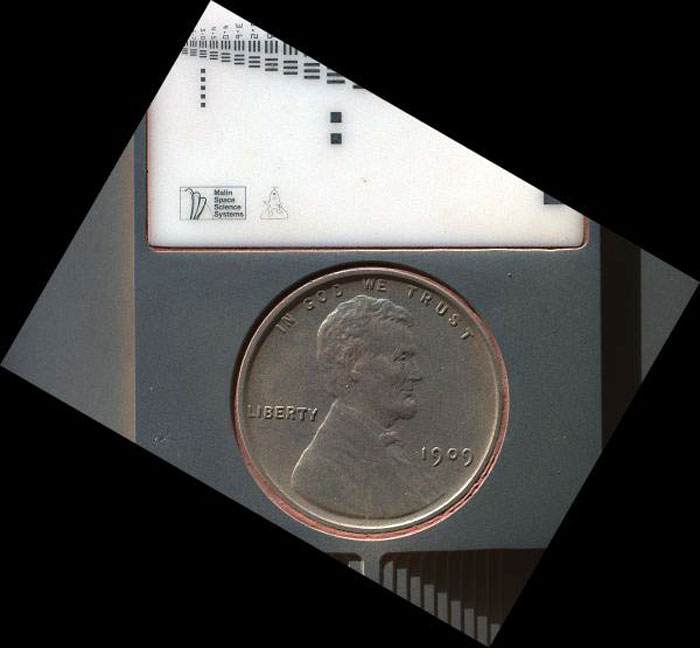
The penny in this image is part of a camera calibration target on NASA's Mars rover Curiosity. The Mars Hand Lens Imager (MAHLI) camera on the rover took this and other images of the MAHLI calibration target during the 34th Martian day, or sol, of Curiosity's work on Mars (Sept. 9, 2012).
The image was acquired with MAHLI at a distance of 5 centimeters (2 inches). MAHLI can acquire images of even higher resolution and can be positioned as close as 2.5 centimeters (about 1 inch); however, as this is the first checkout of the robotic arm, it was decided not to attempt to place the MAHLI at its closest focus distance during this test. The image shows that the calibration target has a coating of Martian dust on it. This is unsurprising — the target was facing directly toward the plume of dust stirred up by the sky crane's descent engines during the final phase of the 6 August 2012 landing.
The penny is a nod to geologists' tradition of placing a coin or other object of known scale as a size reference in close-up photographs of rocks, and it gives the public a familiar object for perceiving size easily when it will be viewed by MAHLI on Mars.
The specific coin, provided by MAHLI's principal investigator, Ken Edgett, is a 1909 "VDB" penny. That was the first year Lincoln pennies were minted and the centennial of Abraham Lincoln's birth. The VDB refers to the initials of the coin's designer, Victor D. Brenner, which are on the reverse side. Brenner based the coin's low-relief portrait of Lincoln on a photograph taken Feb. 9, 1864, by Anthony Berger in the Washington, D.C. studio of Mathew Brady.
The calibration target for the Mars Hand Lens Imager (MAHLI) instrument also includes a "Joe the Martian" character, color references, a metric bar graphic, and a stair-step pattern for depth calibration. The MAHLI adjustable-focus, color camera at the end of Curiosity's robotic arm can be used for taking extreme close-ups of rocks and soil on Mars, as well as images from greater distances.
The Joe the Martian character appeared regularly in a children's science periodical, "Red Planet Connection," when Edgett directed the Mars outreach program at Arizona State University, Tempe, in the 1990s. Joe was created earlier, as part of Edgett's schoolwork when he was 9 years old and NASA's Mars Viking missions, launched in 1975, were inspiring him to dream of becoming a Mars researcher.
-
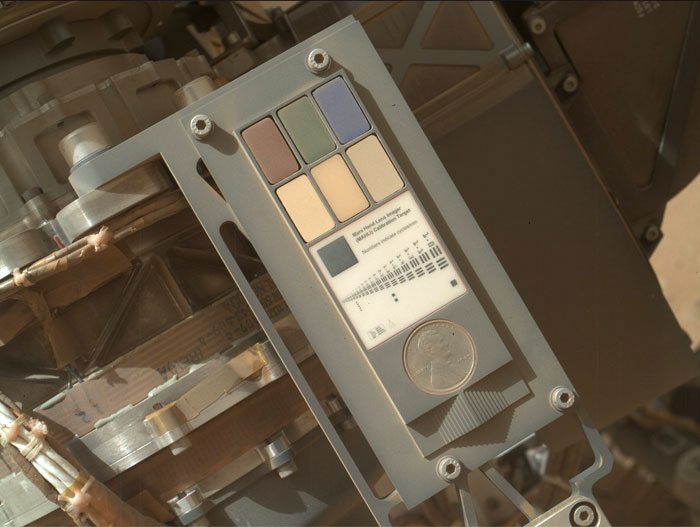
This image was taken by Mars Hand Lens Imager (MAHLI) onboard NASA's Mars rover Curiosity on Sol 34 (2012-09-10 01:58:12 UTC) .
Image Credit: NASA/JPL-Caltech/Malin Space Science Systems
-
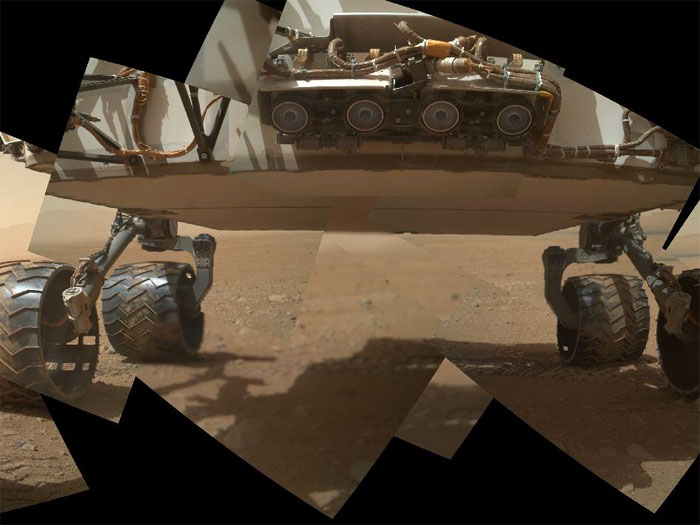
Panorama of Curiosity's Belly Check
This view of the lower front and underbelly areas of NASA's Mars rover Curiosity combines nine images taken by the rover's Mars Hand Lens Imager (MAHLI) during the 34th Martian day, or sol, of Curiosity's work on Mars (Sept. 9, 2012).
Curiosity's front Hazard-Avoidance cameras appear as a set of four blue eyes at the top center of the portrait. Fine-grain Martian dust can be seen adhering to the wheels, which are about 16 inches (40 centimeters) wide and 20 inches (50 centimeters) in diameter. The bottom of the rover is about 26 inches (66 centimeters) above the ground. On the horizon at the right is a portion of Mount Sharp, with dark dunes at its base.
The camera is in the turret of tools at the end of Curiosity's robotic arm. The Sol 34 imaging by MAHLI was part of a week-long set of activities for characterizing the movement of the arm in Mars conditions. As this was a test to gain new information about operation of the instrument, the MAHLI team noted that two of the nine images acquired for this mosaic were not in focus.
The main purpose of Curiosity's MAHLI camera is to acquire close-up, high-resolution views of rocks and soil at the rover's Gale Crater field site. The camera is capable of focusing on any target at distances of about 0.8 inch (2.1 centimeters) to infinity, providing versatility for other uses, such as views of the rover itself from different angles.
Image credit: NASA/JPL-Caltech/Malin Space Science Systems
-
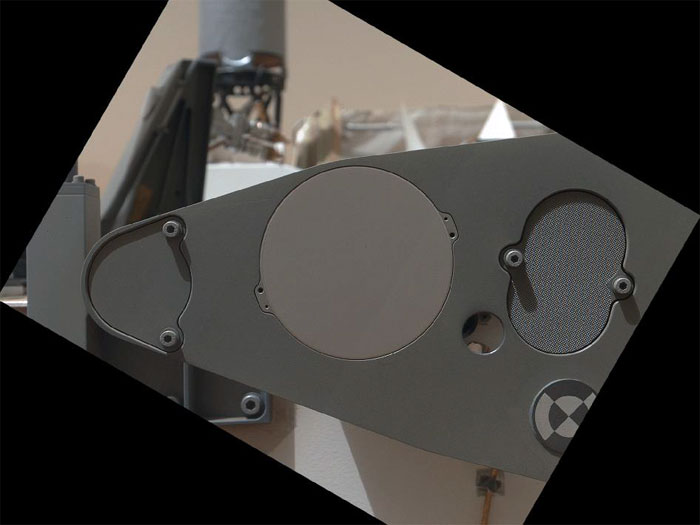
Sealed Organic Check Material on Curiosity
NASA's Mars rover Curiosity carries five cylindrical blocks of organic check material for use in a control experiment if the rover's Sample Analysis at Mars (SAM) laboratory detects any organic compounds in samples of Martian soil or powdered rock. The blocks are carried on the front of the rover, within reach of the sample-collecting drill on the rover's arm, and are sealed under foil until needed. This image centered on the foil that covers one of the bricks was taken by the rover's Mars Hand Lens Imager (MAHLI) during the 34th Martian day, or sol, of Curiosity's work on Mars (Sept. 9, 2012).
The image has been rotated to compensate for the tilted orientation of the camera when it was taken. The diameter of the covering is about 2.5 inches (6.5 centimeters). The rover's UHF radio antenna, mounted on the rear of the deck, is the feature in the background resembling a miniature water tower.
The Sol 34 imaging was part of characterization testing of the rover's arm. This image checks the precision of the arm's positioning as if preparing to collect a sample of the check material. The darker, oval-shaped feature to the right of the foil covering and a rounder dark feature to the left are touch points for the rover's drill to use when the drill collects a powdered sample of the organic check material later in the mission.
If SAM does detect organics, one challenge will be to confirm that these molecules are truly Martian, not stowaways from Earth carried to Mars on Curiosity. The organic check material is a silicon-dioxide ceramic laced with small amounts of synthetic fluorinated organic chemicals not found in nature on Earth and not expected on Mars. The basic control experiment will collect a powdered sample from an organic check block with the same drilling, processing and delivery system used for collecting samples from Martian rocks, and then will analyze the sample with SAM. If SAM finds any organics other than the fluorine-containing markers, they will be stowaway suspects. If only the markers are detected, that would verify that organic-detection is working and that the sample-acquisition and handling pathway has passed a test of being clean of organic stowaways. That control experiment can assess characteristics of organic contamination at five different times during the mission, using the five bricks of check material.
The main purpose of Curiosity's MAHLI camera is to acquire close-up, high-resolution views of rocks and soil at the rover's Gale Crater field site. The camera is capable of focusing on any target at distances of about 0.8 inch (2.1 centimeters) to infinity, providing versatility for other uses.
Image credit: NASA/JPL-Caltech/Malin Space Science Systems
-
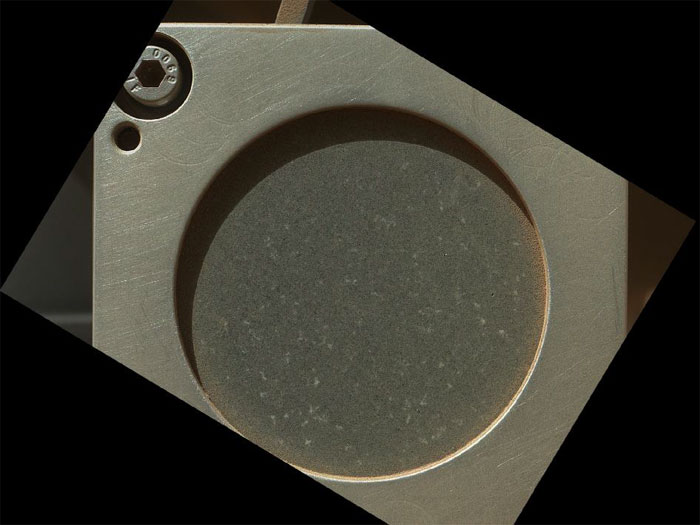
A Piece of New Mexico on Mars
A sample of basaltic rock from a lava flow in New Mexico serves as a calibration target carried on the front of NASA's Mars rover Curiosity for the rover's Canadian-made Alpha Particle X-Ray Spectrometer (APXS) instrument. This image of the APXS calibration target was taken by the rover's Mars Hand Lens Imager (MAHLI) during the 34th Martian day, or sol, of Curiosity's work on Mars (Sept. 9, 2012). The image has been rotated to compensate for the tilted orientation of the camera when it was taken.
The prepared slab of well-characterized dark rock collected near Socorro, N.M., is held in a nickel mounting. The circular opening revealing the rock is about 1.4 inches (3.5 centimeters) in diameter.
The Sol 34 imaging was part of characterization testing of the rover's arm and tools on the arm. A subsequent step commanded the arm-mounted APXS instrument to take a reading of the composition of the calibration target. Curiosity will use the target from time to time during the mission, checking the continuing performance and calibration of the APXS instrument.
APXS can identify chemical elements in rocks and soils. The spectrometer uses the radioactive element curium as a source to bombard the target with energetic alpha particles (helium nuclei) and X-rays. This causes each element in the target to emit its own characteristic X-rays, which are then registered by an X-ray detector chip inside the instrument's sensor head.
The rock in the calibration target is the hardest basalt of more than 200 types tested by the APXS team. Hardness was a desired attribute for preventing the target from breaking during the stresses of launch and landing. In addition, this basalt is low in sulfur, nickel and chlorine. Those elements are common in Martian dust. Thus, scientists using APXS will more easily detect and account for any Martian dust on the calibration target.
Image credit: NASA/JPL-Caltech/Malin Space Science Systems
-
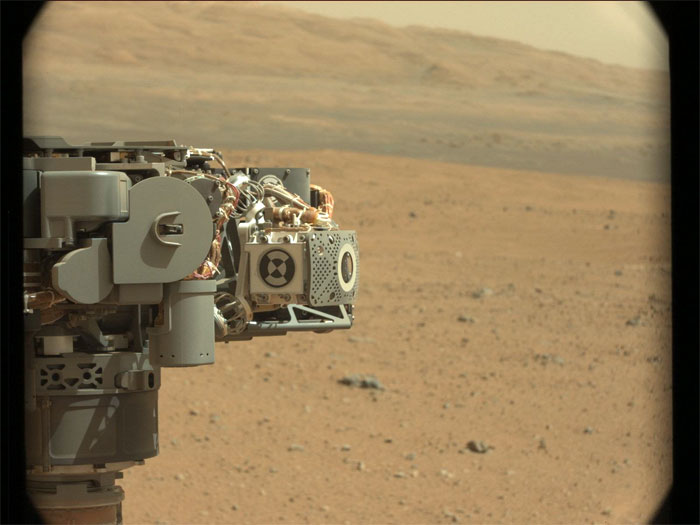
This image was taken by Mastcam: Left (MAST_LEFT) onboard NASA's Mars rover Curiosity on Sol 32 (2012-09-08 00:33:55 UTC) .
Quelle: NASA
6143 Views
